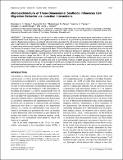Microarchitecture of Three-Dimensional Scaffolds Influences Cell Migration Behavior via Junction Interactions
Author(s)
Harley, Brendan A. C.; Kim, Hyung-Do; Zaman, Muhammad H.; Yannas, Ioannis V.; Lauffenburger, Douglas A.; Gibson, Lorna; ... Show more Show less
DownloadGibson-Microarchitecture.pdf (545.3Kb)
MIT_AMENDMENT
MIT Amendment
Article is made available in accordance with the publisher's policy and may be subject to US copyright law. Please refer to the publisher's site for terms of use.
Terms of use
Metadata
Show full item recordAbstract
Cell migration plays a critical role in a wide variety of physiological and pathological phenomena as well as in scaffold-based tissue engineering. Cell migration behavior is known to be governed by biochemical stimuli and cellular interactions. Biophysical processes associated with interactions between the cell and its surrounding extracellular matrix may also play a significant role in regulating migration. Although biophysical properties of two-dimensional substrates have been shown to significantly influence cell migration, elucidating factors governing migration in a three-dimensional environment is a relatively new avenue of research. Here, we investigate the effect of the three-dimensional microstructure, specifically the pore size and Young's modulus, of collagen-glycosaminoglycan scaffolds on the migratory behavior of individual mouse fibroblasts. We observe that the fibroblast migration, characterized by motile fraction as well as locomotion speed, decreases as scaffold pore size increases across a range from 90 to 150 μm. Directly testing the effects of varying strut Young's modulus on cell motility showed a biphasic relationship between cell speed and strut modulus and also indicated that mechanical factors were not responsible for the observed effect of scaffold pore size on cell motility. Instead, in-depth analysis of cell locomotion paths revealed that the distribution of junction points between scaffold struts strongly modulates motility. Strut junction interactions affect local directional persistence as well as cell speed at and away from the junctions, providing a new biophysical mechanism for the governance of cell motility by the extracellular microstructure.
Date issued
2008-10Department
Massachusetts Institute of Technology. Department of Biological Engineering; Massachusetts Institute of Technology. Department of Materials Science and Engineering; Massachusetts Institute of Technology. Department of Mechanical EngineeringJournal
Biophysical Journal
Publisher
Elsevier B.V. for the Biophysical Society
Citation
Harley, Brendan A.C. et al. “Microarchitecture of Three-Dimensional Scaffolds Influences Cell Migration Behavior via Junction Interactions.” Biophysical Journal 95.8 (2008): 4013-4024.© 2008 The Biophysical Society.
Version: Final published version
ISSN
0006-3495
1542-0086